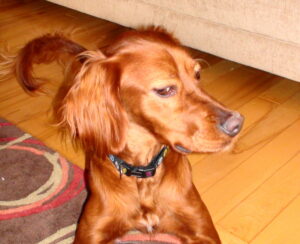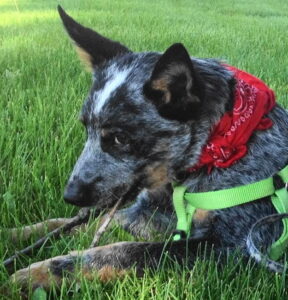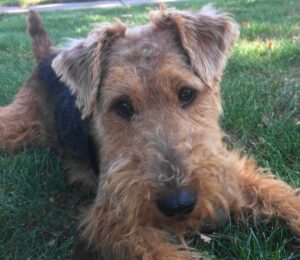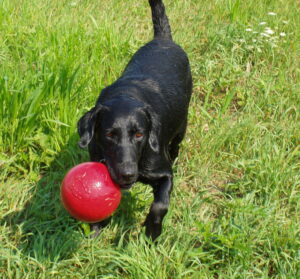Barks Blog
Preventing Resource Guarding in Dogs

Resource guarding is a dog’s natural tendency to protect valued possessions such as food, toys or resting locations. From a dog’s perspective, the approach of a person or animal is a potential threat to losing the valued possession. The behavior reflects a lack of trust and a fear of loss.
Dogs in the wild must guard their food, water and shelter or they cannot survive. Domestic dogs will of course survive if someone takes their chew bone away, but their behavior is influenced by 32,000 years of evolution. If a dog perceives a threat, he may choose to protect it. He may also experiment until he finds an option that works for him.
What Resource Guarding Looks Like

You may see a dog lower his head while glaring up at the intruder with whale eyes. The dog’s mouth may close tightly as he freezes, or he may rapidly chew and gulp the item. There may be low guttural growls as warnings, and if the person comes closer the dog may snap or bite.
An Ounce of Prevention
Like any behavior issue, it is better to prevent resource guarding than to address it after it has become an established pattern. Fortunately, that is easy to do. I lump the process into two steps. First, do not accidentally trigger guarding behavior. Second, preempt guarding by teaching incompatible alternative behaviors.
Old-fashioned Notions Can Lead to Trouble
When I got my first puppy in 1983 many trainers recommended messing with a puppy while he was eating, so he would “get used to it” and accept the intrusion. This may involve offering food and then putting one’s hands in the bowl, or taking away the bowl before the puppy has finished eating.
Some of my clients have expressed that they “should” be able to do such things, and that their dog “should” accept it. That has more to do with human ego than with canine evolution and behavior. The dog, on the other hand, may be thinking “I should be able to enjoy my meal without humans bothering me…just because they can.” Try to empathize with the dog.
Imagine that your family has gone to a favorite restaurant to celebrate the “end” of the pandemic, at some time in the future. The waitstaff bring your meals and just as you are finally enjoying dining out, they return to your table and take away your food. If the same thing happened on repeated occasions your frustration and resentment would escalate, just as dogs grow tired of such harassment.
Your family members would soon learn to see the approach of waitstaff with a lack of trust, fearing that their food would be taken away. What might they do to stop the waitstaff?
A puppy may also learn guarding behavior if owners over-react and forcibly remove objects from the dog’s mouth. One adolescent dog that I worked with naturally explored the world with his mouth, as a puppy. As so many puppies are apt to do, he picked tissues from the trash bin or grabbed up a sock off the floor.
Upon seeing that, the owners yelled at their puppy, who ran away with the object. They chased him until they caught him, and then restrained the scared pup and forcibly removed the object from his mouth. By six months of age their dog had learned that nipping kept human hands away.
Nipping evolved into biting, and the dog began guarding far more than tissues and socks. While walking outdoors the dog guarded ants on the sidewalk, and leaves on nearby plants. Inside, the dog leapt and snatched food from the owner’s hands or from the kitchen counter or table. He inflicted deep bites on several occasions.
“If your dog is already guarding objects, you should seek a professional to work with you, whose methods are force-free. Studies show that aversive punishment can cause unintended harmful consequences and even increase aggressive behavior. Without professional coaching you may make mistakes, making matters worse.”
Modern Dog Training Methods Teach Confidence and Trust

If your puppy has not learned to guard valued possession, congratulations! Here are some easy things you can do to keep it that way.
I recommend leaving a dog alone until his meal or treat is consumed. In my home we set down food bowls so Buddha and Gandhi can eat a few feet apart from one another, and I remove the bowls only after they have walked away from them. They have no reason to fear the other dog will take their food, or that I will pester them.
If you use a food bowl, when your pup is eating just approach and put some extra high value food in the bowl, and then walk away. You can do the same thing if he has a bone or a toy. He will learn that your approach brings a bonus, and he gets to keep what he was enjoying in the first place.
Feeding by hand is an easy way to condition your dog to appreciate incoming hands. Put some food in your hand, close your fist and lower your hand below the dog’s mouth. Then open your hand, palm up. He will learn that hands offer more food, rather than taking things away.
“Leave It” is a great behavior to teach any dog. I taught Buddha and Gandhi that “Leave It” means two things.
First, if they are interested in or approaching something, they should stop and look at me. Then I will give them an alternative behavior which I can reward, such as (“Touch”) hand targeting. Living in the countryside I have used this many times during trail walks when my dogs began chasing a rabbit, coyote or a deer. They responded perfectly every time.
One summer day I was walking with Buddha on a trail. Buddha was about 50 feet ahead of me when he spotted a rabbit, who was about 30 feet ahead of him. The bunny bolted and Buddha sprinted after him, gaining ground on his intended prey. When I said “Leave it” Buddha kept running at full speed, but sharply turned in a half-circle and ran back to me with a happy expression on his face. There was a happy expression on my face too!
The second function of the “Leave It” cue is to drop whatever they already have in their mouth. One morning Gandhi was let out the garage door, which is near a bird feeding station. He caught a squirrel beneath the feeder and had it entirely in his mouth. When he heard “Leave It” he dropped the squirrel, who fell to the ground and scampered away to climb a nearby tree.
Some trainers prefer to teach a separate “Drop” or “Off” cue. Whatever cues you wish to use, teaching a dog to happily give up a pursuit or a possession can be a life-saving skill.
I teach “Take It & Leave It” to each of my client’s dogs. I use a variety of items that a dog may enjoy, such as a food-filled Kong, Bully stick or other item. Hold the item firmly in your hand and cheerfully say “Take it!” as you offer the other end to him. Keep a supply of excellent food in your other hand, behind your back and let him mouth the object for a few seconds.
Say “Leave It” and then offer the hidden food to your dog’s mouth. While he eats the food, place the toy behind your back. When he has eaten the food, say “Take it!” and offer the item again. With a few repetitions he will soon be opening his mouth to let go of the item, to receive his bonus. This teaches your pup that letting go of the item is rewarded with a bonus, and then he gets the item back.
I teach clients to use this in combination with “Find It” so they have a simple way to retrieve objects that their dog should not have. First, I teach “Find It” so the dog learns to follow my eyes and hand gesture to go search a location. Dogs are especially good at using their nose to sniff out food.
Then I show the client how to use “Take It” to cue their dog to grab an item with his mouth. While the dog is enjoying mouthing the item, I toss bits of meat several feet away, and cue him “Leave It” to let go of the item. That is quickly followed up by cueing the dog to “Find It” and search for treats in the direction I am pointing. My clients often remark how easy it is for them to retrieve objects without triggering a conflict with their pet.
One of my favorite client dogs began guarding his resting spot on the sofa, and on the bed. If Rocket was on the furniture first, he would growl at the husband or wife when they approached. This was a new adolescent behavior and it was resolved in less than an hour. The owners wisely called me for help before Rocket became proficient at resource guarding.
I began with Rocket standing on the floor and cued him to get up on the furniture. Then I said “Off” and tossed a piece of meat onto the floor, several feet away. He happily went to get his treat, and then I cued him to get back onto the furniture. Rocket never got a treat for hopping onto the furniture, but he always got one for hopping off. Very quickly, he showed a preference to remain on the floor and “Off” became a trained cue. His owners had a safe way to get him off furniture, and could invite him to join them, if they pleased.

Fetch is another fun game. Have two toys ready and toss the first one. When your dog returns it, quickly toss the second one. He will learn that bringing things to you and dropping them is a fun game.
In Conclusion
No doubt there are many other ways to teach dogs fun and rewarding behaviors which are incompatible with resource guarding. In my experience, the key is teaching family members that they have alternatives to chasing their dogs and wrestling items away from them. They too are learning behaviors which are incompatible with resource guarding, force-free.
Click here to find a professional force-free dog trainer.
Resources
Anderson, E. (2015). Fallout From the Use of Aversives
Nilson, S. (2014). Resource Guarding: Knowing the Signs
© Daniel H. Antolec, 2020
